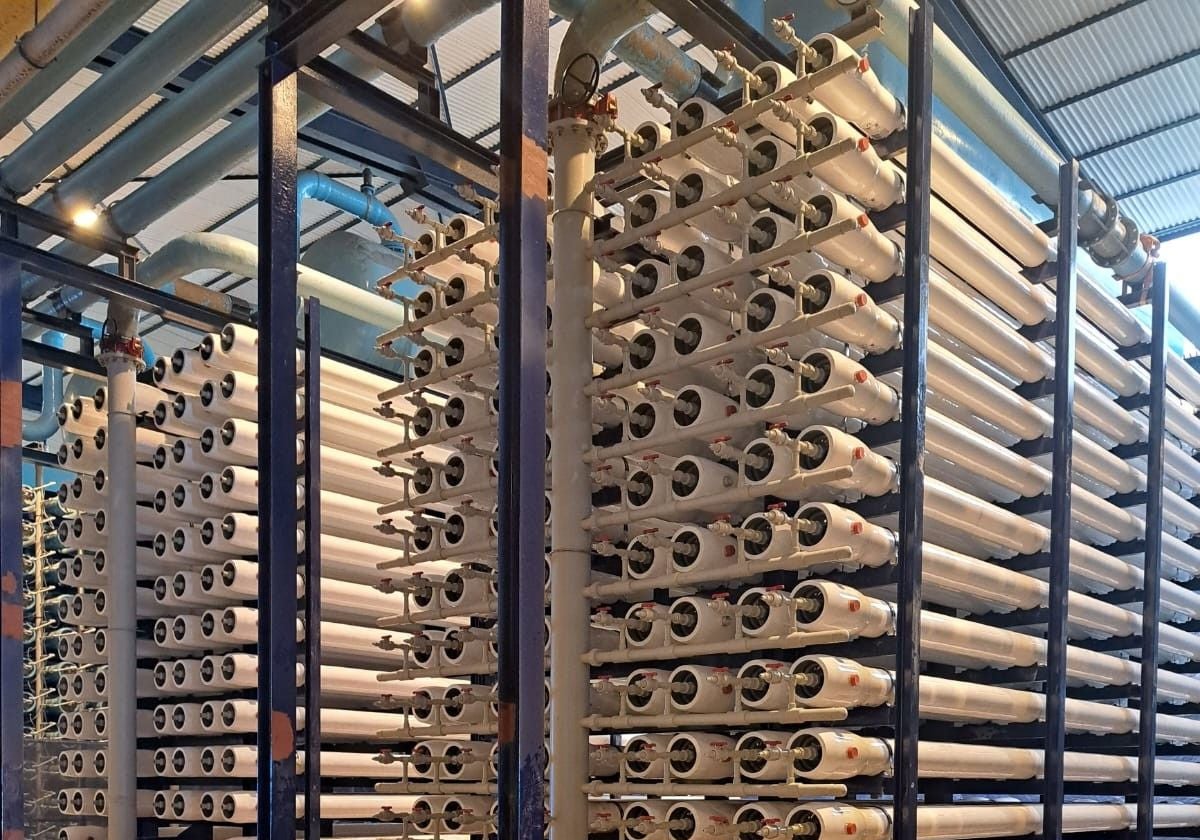Marbella desalination plant has supplied the Costa del Sol with water to fill two La Concepción reservoirs in the last 20 years
On 31 May it will produce 20 million cubic metres per year, one fifth of the water supply along the western Costa del Sol. Its modernisation requires an investment of 17 million euros
Marbella's seawater desalination plant will have been in operation for twenty years this summer. It was on 12 July 2005, after several years of technical, legal and financial wranglings, that it began to treat seawater. Cristina Narbona the minister for the environment at the time. The plant is owned by the central government and operated by Acosol, the public water company managed by the Mancomunidad association of town halls on the western Costa del Sol and the Junta de Andalucía.
The date has been set for the plant to be restored to full capacity. The technician in charge is Miguel Esteban, who announced the deadlines for the recovery of the 20 million cubic metres of nominal capacity a few days ago at an event to mark 30th anniversary of Acosol. Esteban said that the second phase of the project will come to an end on 31 May.
17 million
The investment exceeds the upgrade of the desalination plant (two phases of expansion and one energy phase).
The plant had gradually lost operational capacity. From being able to treat 20 million cubic metres per year, which represents just over a fifth of the Costa del Sol's consumption, it was only able to produce six.
The technician emphasised the strategic importance of the facility, which came about as a result of the severe drought of 1995. At that time, La Concepción reservoir stored only 0.4 million cubic metres, well below the threshold of a 'dead' dam. The regional government is now in the process of tendering the contract to rehabilitate the system of intakes and pumping in order to make the most of every last drop of water in the event of a future drought.
In its 'working life', the desalination plant has injected 116 million cubic metres into the upstream distribution network. This is the supply of the coast for 15 months or, in Esteban's own words, as much as two full reservoirs at La Concepción. He explained that the maximum annual peak reached 10 million cubic metres in 2012.
The first phase of the expansion, which allowed a rise from six million cubic metres to 12, was completed in November last year. The second phase began almost in parallel with the complication of the delay in the arrival of components and supplies due to the geopolitical crisis in the Red Sea.
[Antetitulo]
116 million cubic metres
have been contributed to the supply network by the plant since its activation in 2005.
However, the investments to upgrade the desalination plant do not end here. A tender to modernise the plant's energy system is currently being evaluated with the aim of saving 30 per cent of energy. It is a mega-contract that has been tendered for 10 million euros. The Andalusian Energy Agency is providing three million euros and there is a possibility of European funding. The rest will come from the Mancomunidad's improvement fee. All in all, all the actions amount to more than a whopping 17 million and will serve to leave this strategic infrastructure in a perfect state of repair.
The plant has eight reverse osmosis membrane racks. Each line produces 7,200 cubic metres per day. The brine rejects are around half of the flow. The desalinated water is mixed with the water coming from the reservoir and the drinking water treatment process begins at the ETAP del Verde, also in the initial phase for its essential 36-million-euro expansion.
The plant's water catchment is located 500 metres offshore at the mouth of the Verde river, 2.5 kilometres from the desalination plant and next to the western beach of Puerto Banús. The plant is on the Istán road, very close to the aforementioned DWTP. The brine is returned to the sea 350 metres from the beach and 7 metres deep through an outfall. The outfall is discharged through eight diffusers.
The desalination plant was built in 1997 and had the 'Jesús Gil stamp' both in the determination to build it and in the judicial problems that followed.
La Costa needs a second desalination plant: Acosol studies location
During the aforementioned conferences, the need to work on a second desalination plant for the coast, with a similar capacity to that of Marbella, was put on the table. But it will not be able to go on the land of the one that was awarded between Mijas and Fuengirola.
The location has not been specified, but according to the CEO of the public company, Matilde Mancha, it will be in the easternmost part of the Costa del Sol, between Torremolinos and Mijas. The preliminary project will be worked on hand in hand with the Ministry of Agriculture of the Andalusian Regional Government and Acosol has included it in its investment plan, which exceeds 350 million euros over five years.
Mancha defined this medium-term action as key. And he highlighted the conjunction with short-term projects such as the improvement of the current desalination plant and the medium-term projects such as the extension of the Verde drinking water treatment plant. In the long term, the Gibralmedina reservoir, between Cadiz and Malaga, which will regulate the flows of the Guadiaro and allow the transfer of up to 15 cubic hectometres of treated water per year from the Campo de Gibraltar, was key.

